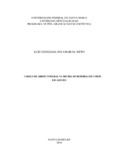| dc.creator | Amaral Neto, Luiz Gonzaga do | |
| dc.date.accessioned | 2016-09-01 | |
| dc.date.available | 2016-09-01 | |
| dc.date.issued | 2016-02-22 | |
| dc.identifier.citation | AMARAL NETO, Luiz Gonzaga do. WHOLE RICE BRAN IN THE REARING BEEF HEIFERS IN ITALIAN RYEGRASS. 2016. 62 f. Dissertação (Mestrado em Zootecnia) - Universidade Federal de Santa Maria, Santa Maria, 2016. | por |
| dc.identifier.uri | http://repositorio.ufsm.br/handle/1/10918 | |
| dc.description.abstract | The experiment was carried out with the objective of evaluating the gross margin, the productive and reproductive performance of beef heifers kept exclusively on ryegrass pasture (Lolium multiflorum Lam.) or ryegrass receiving 0.5 and 1.0% of body weight (BW) of whole rice bran as supplement, provided daily at at 2:00 p.m. The grazing method was the rotational and the interval between grazings was set by the thermal sum required for the appearing of 1.5 ryegrass leaf (187.5º C). The experimental design was completely randomized with repeated measures, three feeding systems and two and two area replications. Heifers in different feeding systems were kept in similar forage mass and canopy height when they came out of plots in all paddocks. The heifers average daily gain did not differ between the feeding systems. The stocking rate and weight gain per area were higher when heifers received 1.0% BW of whole rice bran. The provision of 0.5% BW of WRB allowed stocking rate and capacity gain for intermediate area between the other feeding systems. The higher gross margin was observed when heifers received 0.5% BW. The variable cost obtained for the different feeding systems showed increasing behavior depending on the WRB levels, surpassing the exclusive use of ryegrass in 37.2% and 60.6%. The final body weight, body condition score and reproductive tract score did not differ between the feeding systems. Considering an adult animal with an average body weight of 450 kg, the heifers at the beginning of the experiment showed 34% of mature body weight and final average body weight of 56% of adult weight. | eng |
| dc.format | application/pdf | por |
| dc.language | por | por |
| dc.publisher | Universidade Federal de Santa Maria | por |
| dc.rights | Acesso Aberto | por |
| dc.subject | Ganho por área | por |
| dc.subject | Lolium multiflorum Lam. | por |
| dc.subject | Margem bruta | por |
| dc.subject | Suplemento | por |
| dc.subject | Taxa de lotação | por |
| dc.subject | Weight gain per area | eng |
| dc.subject | Lolium multiflorum Lam. | eng |
| dc.subject | Gross margin | eng |
| dc.subject | Supplement | eng |
| dc.subject | Stocking rate | eng |
| dc.title | Farelo de arroz integral na recria de bezerras de corte em azevém | por |
| dc.title.alternative | Whole rice bran in the rearing beef heifers in italian ryegrass | eng |
| dc.type | Dissertação | por |
| dc.description.resumo | O experimento foi conduzido com o objetivo de avaliar a margem bruta, o desempenho produtivo e reprodutivo de bezerras de corte mantidas exclusivamente em pastagem de azevém (Lolium multiflorum Lam.) ou em azevém recebendo 0,5 e 1,0% do peso corporal (PC) de farelo de arroz integral (FAI) como suplemento, fornecido diariamente às 14 horas. O método de pastejo foi o rotativo e o intervalo entre pastejos foi estabelecido considerando a soma térmica necessária para a emissão de 1,5 folha de azevém (187,5º C). O delineamento experimental foi o inteiramente casualizado, com medidas repetidas no tempo, três sistemas alimentares e duas repetições de área. As bezerras, nos diferentes sistemas alimentares, foram mantidas em similar massa de foragem e altura de dossel quando saíram das parcelas em todos os piquetes. O ganho médio diário das bezerras não diferiu entre os sistemas alimentares. A taxa de lotação e o ganho de peso por área foram maiores quando as bezerras receberam 1,0% do PC de farelo de arroz integral. O fornecimento de 0,5% do PC de FAI permitiu taxa de lotação e ganho por área intermediários entre os demais sistemas alimentares. A maior margem bruta foi observada quando as bezerras receberam 0,5% de FAI. O custo variável obtido para os diferentes sistemas alimentares apresentou comportamento crescente em função dos níveis de FAI, superando o uso exclusivo do azevém em 37,2% e 60,6%. O peso corporal final, o escore de condição corporal e o escore do trato reprodutivo não diferiram entre os sistemas alimentares. Considerando um animal adulto com peso corporal médio de 450 kg, as bezerras ao início do experimento apresentaram 34% do peso corporal adulto e peso corporal final médio de 56% do peso adulto. | por |
| dc.contributor.advisor1 | Pötter, Luciana | |
| dc.contributor.advisor1Lattes | http://buscatextual.cnpq.br/buscatextual/visualizacv.do?id=K4796005T7 | por |
| dc.contributor.referee1 | Quadros, Fernando Luiz Ferreira de | |
| dc.contributor.referee1Lattes | http://buscatextual.cnpq.br/buscatextual/visualizacv.do?id=K4780560Z8 | por |
| dc.contributor.referee2 | Souza, Alexandre Nunes Motta de | |
| dc.contributor.referee2Lattes | http://buscatextual.cnpq.br/buscatextual/visualizacv.do?id=K4764557J9 | por |
| dc.creator.Lattes | http://lattes.cnpq.br/4101738609193958 | por |
| dc.publisher.country | BR | por |
| dc.publisher.department | Zootecnia | por |
| dc.publisher.initials | UFSM | por |
| dc.publisher.program | Programa de Pós-Graduação em Zootecnia | por |
| dc.subject.cnpq | CNPQ::CIENCIAS AGRARIAS::ZOOTECNIA | por |


